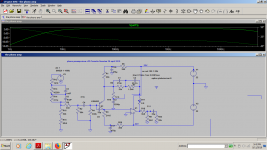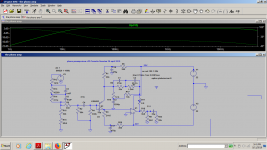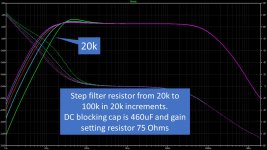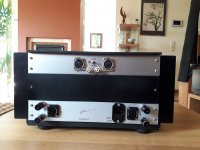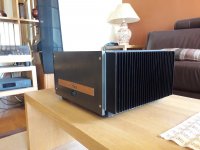In all active equalizers, one trick is to run a resistor from the output of the opamp back to the top of the DC blocking capacitor where it connects with the lower arm of the gain setting resistor. If you select the resistor correctly, you get c 12 dB gain reduction vs 20 Hz at 6-8 Hz. The LT1115 data sheet RIAA has an example.
Why did you betray the active feedback secrets ? You must be punished now 🙂
Attachments
This is the version I have GOODMAN, Benny - The Complete Benny Goodman Carnegie Hall Concert 1938 - Jasmine Records bought on a friend's recommendation. The differences should be quite obvious, I haven't heard the legacy version. Click on "Download Notes (PDF)" for the whole story, I think you'll find it interesting@Scottjoplin, you mentioned the Benny Goodman 1938 concert, I found the Columbia Legacy version, you ought to hear differences.
Thanks, yes I know, I got hold of the other copy 😉.
The Legacy copy has crackles and pops and surface noise, and interesting spoken word segments....I find spoken word is very useful signal.
I believe the Jasmine transcription is Cedarised, a denoising/restoration processing that has detractors.
Perhaps you could send me a track or part of a track that you know and I do my processing and then you can have multiple comparisons.
In my search for the Jasmine version I also found reference to books about the recording...try archive.org.
Dan.
The Legacy copy has crackles and pops and surface noise, and interesting spoken word segments....I find spoken word is very useful signal.
I believe the Jasmine transcription is Cedarised, a denoising/restoration processing that has detractors.
Perhaps you could send me a track or part of a track that you know and I do my processing and then you can have multiple comparisons.
In my search for the Jasmine version I also found reference to books about the recording...try archive.org.
Dan.
Last edited:
470uF gives a MC low frequency corner of about 15Hz (slightly lower due to the cartridge few ohms impedance). I wonder how you kept the 20Hz RIAA with this single LF pole, the error at 20Hz is about -2.5dB.
You don't try to - the subsonic filter lifts the response (i.e. peaks) between 100Hz and ~20 Hz by about 2 dB as you point out. My values are a bit different so I'm not down as much at 20Hz. The peaking makes for a slightly 'heavier' bass but this is vinyl . . . if some find it objectionable then head over to the 'Cartridge dynamic behaviour thread' and look at the typical cart responses to allay their fears.
On another phono amp, I don't have this but just a subsonic filer after the main RIAA EQ stage - the peaking is much less (about 0.5 dB IIRC) with it switched in.
Attachments
Last edited:
I haven't had it long so not that familiar with it yet, also don't have the tech to send you anything anyway. Thanks for the offer
And the rumble as well ?You don't try to - the subsonic filter lifts the response (i.e. peaks) between 100Hz and ~20 Hz by about 2 dB
200W CFA now converted to VFA with balanced inputs with no eight legs inside (except DC servo).
This amp enclosure was built having in mind to get fabulous sound out of it. It is well known that ferrous metal is not good, even aluminium if used in big quantity will get harsh cold sound,so no big milled chunk is used, just aluminium frame. To get warm sound wood was used, like bottom plate(laminated wood), wooden feet (fir), top plate(HDF) all to get the best possible sound. 🙄 😉
Richard, I hope you like my type of that amp case? Probably not possible to drive some loudspeakers with 2 ohm dip in impedance, heat sink not big enough for that, but big enough to drive 4 ohm to full power.
BR Damir
This amp enclosure was built having in mind to get fabulous sound out of it. It is well known that ferrous metal is not good, even aluminium if used in big quantity will get harsh cold sound,so no big milled chunk is used, just aluminium frame. To get warm sound wood was used, like bottom plate(laminated wood), wooden feet (fir), top plate(HDF) all to get the best possible sound. 🙄 😉
Richard, I hope you like my type of that amp case? Probably not possible to drive some loudspeakers with 2 ohm dip in impedance, heat sink not big enough for that, but big enough to drive 4 ohm to full power.
BR Damir
Attachments
You don't try to - the subsonic filter lifts the response (i.e. peaks) between 100Hz and ~20 Hz by about 2 dB as you point out. My values are a bit different so I'm not down as much at 20Hz. The peaking makes for a slightly 'heavier' bass but this is vinyl . . . if some find it objectionable then head over to the 'Cartridge dynamic behaviour thread' and look at the typical cart responses to allay their fears.
On another phono amp, I don't have this but just a subsonic filer after the main RIAA EQ stage - the peaking is much less (about 0.5 dB IIRC) with it switched in.
I don't understand why using a subsonic filter that peaks - any 3rd order Sallen-Key filter tuned to 10-11Hz will do the job with virtually zero impact on the RIAA 20Hz frequency response. Being of an odd order, only a dual op amp is required to implement, can't get better/simpler than this.
Using a low RC low pass constant, then a peaking high pass filter to compensate the LF frequency drop is IMO an as dumb as it gets idea. Measure your group delay (or calculate using Gd(w)=-Re[H'(s)/H(s)] for s=jw), you may have a pretty nasty surprise. Unless you care only about your customer satisfaction, which I'm sure it's high, disregarding the solution you would choose.
Last edited:
200W CFA now converted to VFA with balanced inputs with no eight legs inside (except DC servo).
<snip>
Please stop advertising your stuff in this thread. You have your own thread (actually several) for this.
Yeah, lead is a poison, but now I know to wash my hands after touching solder, unlike when I was building my first Heathkit at age 8.
I thought the issue with leaded solder was not the handling but the eventual disposal of the equipment which lead to it ban. Think about how many mobile phones hit the dump ever day.
Late to the conversation as usual:
Actually I thought that was one of the most interesting circuits (and presentation thereof) that I have seen here. I found the In-amp output stage particularly intriguing, and I have wanted for a long time to try a real diff-in phono stage (though diff-out is useless to me).
Unfortunately I have two very good phono stages now, one for MM and one for MC. I have been using an MC cart exclusively for some time now* and Scott's design seemed only suited to MM. Plus I have another project which has been back-burnered for about a year, and which I want to finish but never seem to get to, so I am loath to start something else before that happens.
youtube
*One disadvantage of a fixed-headshell tonearm is changing carts is a PITA,
>I don't think many people around here appreciate those circuits, judging from the responses of the original thread by Scott.
Actually I thought that was one of the most interesting circuits (and presentation thereof) that I have seen here. I found the In-amp output stage particularly intriguing, and I have wanted for a long time to try a real diff-in phono stage (though diff-out is useless to me).
Unfortunately I have two very good phono stages now, one for MM and one for MC. I have been using an MC cart exclusively for some time now* and Scott's design seemed only suited to MM. Plus I have another project which has been back-burnered for about a year, and which I want to finish but never seem to get to, so I am loath to start something else before that happens.
youtube
*One disadvantage of a fixed-headshell tonearm is changing carts is a PITA,
Yes, one aspect of the ROHS directive is to reduce lead leaching from disposal/landfill and into water tables.I thought the issue with leaded solder was not the handling but the eventual disposal of the equipment which lead to it ban. Think about how many mobile phones hit the dump every day.
Removal of lead from products also has health improvement consequences for workers in the recycling chain.
I maintain that lead causes a lead 'tone' in audio equipment and is best avoided......lead free alloys are 'better' sounding imho.
Dan.
here it is
Thank you Bonsai and Mark
but now I know to wash my hands after touching solder, unlike when I was building my first Heathkit at age 8.
I still lick my fingers after eating chocolate sweeties and after soldering😀
George
I still lick my fingers after eating chocolate sweeties and after soldering😀
You are so dead, on both counts.
Thank you Bonsai and Mark
I still lick my fingers after eating chocolate sweeties and after soldering😀
George
Just think about how many times we brushed our teeth with toothpaste that was stored in a tube made from lead in the old days...
You are so dead, on both counts.
I make space for the younger
🙂
George
Scott's design seemed only suited to MM ....
The version I built has a gain of 1000 at 1kHz.
It uses JFETs only without any integrated circuits or inamps.
Fully discrete.
Cheers,
Patrick
I know I'm tolerated here by Scott...he could destroy me and my whole "knowledge" with just a sentence, but i just plunged in deep ocean...Its kind of a brainstorming here and being defeated by a strong argument is only in your favor, but sometimes it only looks like the reason for why the fish has swallowed Iona...I rather enjoy Dreamth's posts, he seems quite knowledgeable and well studied as well. Were did it go wrong? Can't blame him for reacting with some humor on your broadsides.
I don't like to use low frequency roll-off. I prefer direct and wide low frequency bandwidth. The resonance of the arm-cartridge combination should be enough to reduce record warps. If not, you have a mechanical problem that needs fixing. Rumble? Haven't noticed it in the last 50 years. Is there still some in a quality turntable?
Very good point, but we have a similar "db figures" wars in the turntable world.What i really liked at Japanese manufacturers is that at some point they simply stopped telling anything about rumble as it was useless...they simply mentioned overall SNR:Rumble? Haven't noticed it in the last 50 years. Is there still some in a quality turntable?
Yamaha GT-2000 on thevintageknob.org
Last edited:
- Status
- Not open for further replies.
- Home
- Member Areas
- The Lounge
- John Curl's Blowtorch preamplifier part III
